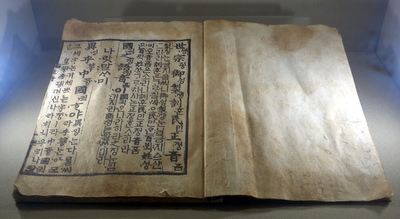Difference between revisions of "Hangul"
| Line 4: | Line 4: | ||
''Hangul'' is the chief writing system employed in Korea. Devised by [[King Sejong]] in the 15th century, it uses consonant and vowel elements which combine to form syllabic characters. Traditionally used alongside [[Kanji|Chinese characters]] (K: ''hanja''), in recent times Korea has largely turned to using ''hangul'' almost exclusively. | ''Hangul'' is the chief writing system employed in Korea. Devised by [[King Sejong]] in the 15th century, it uses consonant and vowel elements which combine to form syllabic characters. Traditionally used alongside [[Kanji|Chinese characters]] (K: ''hanja''), in recent times Korea has largely turned to using ''hangul'' almost exclusively. | ||
| − | ''Hangul'' | + | ''Hangul'' was first developed in [[1443]], but ''[[Hunminjeongeum]]'', a book organized by King Sejong which formally describes and explains the writing system, went through three years of further testing and improvements before being published three years later. Meanwhile, in [[1445]], Sejong released an epic entitled "Songs of Flying Dragons" (K: ''Yongbi Eocheonga''), which describes the founding of the [[Joseon Dynasty]] in five books (ten volumes, 125 chapters), in both ''hangul'' and ''hanja''. |
{{stub}} | {{stub}} | ||
Revision as of 10:44, 27 July 2017

- Korean: 韓㐎・한글 (Hangul)
Hangul is the chief writing system employed in Korea. Devised by King Sejong in the 15th century, it uses consonant and vowel elements which combine to form syllabic characters. Traditionally used alongside Chinese characters (K: hanja), in recent times Korea has largely turned to using hangul almost exclusively.
Hangul was first developed in 1443, but Hunminjeongeum, a book organized by King Sejong which formally describes and explains the writing system, went through three years of further testing and improvements before being published three years later. Meanwhile, in 1445, Sejong released an epic entitled "Songs of Flying Dragons" (K: Yongbi Eocheonga), which describes the founding of the Joseon Dynasty in five books (ten volumes, 125 chapters), in both hangul and hanja.
References
- Gallery labels, The Story of King Sejong museum exhibit, Seoul.